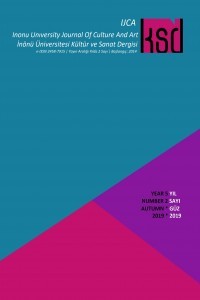PAYDOS SAATİ: LAURENCE STEPHEN LOWRY’NİN ENDÜSTRİYEL PEYZAJI ÜZERİNE BİR DEĞERLENDİRME
1887-1976 yılları arasında yaşayan İngiliz ressam Laurence Stephen Lowry, doğduğu ve yetiştiği yer olan İngiltere’nin kuzey bölgesindeki kent görünümlerini resimlerine konu olarak seçmiştir. Lowry’nin, resimlerinde yer verdiği bu görünümler; dönemin genel özelliklerini yansıtan kent hayatı, fabrikalar, tüten bacalar ve çoğunlukla işçilerden oluşan kalabalık figür gruplarıyla günlük yaşamdan sahneleri yansıtmaktadır. Bu sahneler incelendiğinde, Lowry’nin endüstriyel peyzajlarının; Kuzey İngiltere’nin içinde bulunduğu durum, çağın genel atmosferi, değişen yaşam koşulları, bu koşullar karşısında bireyin yaşadığı dönüşüm ve özellikle 20. yüzyıl Avrupa’sını tümüyle kuşatan modernite gerçeğiyle sıkı bağlara sahip olduğu açık bir şekilde görülmektedir. Bu sebeple, kalabalık gruplar halinde gidiş gelişleriyle resme ritim kazandıran işçiler üzerinden anlatılan ve bu araştırmanın konusunu oluşturan “Paydos Saati” isimli eserin; Kuzey İngiltere’nin endüstrileşme serüveni ve bu serüvenin günlük yaşam ve toplumsal yapıda yarattığı keskin dönüşümden hareketle incelenmesi amaçlanmaktadır. Bu amaç doğrultusunda yapılan literatür taraması ile sanatçının eserleri, yaşadığı coğrafya ve dönem hakkında bilgiler toplanmış, edinilen bilgilerin kılavuzluğunda çağın koşulları ile ilişkilendirilen resim, özellikle endüstrileşmenin toplumsal yansımalarına dair taşıdığı izlerden hareketle çözümlenerek eserin modern dünyaya karşı sahip olduğu eleştirel bakış ortaya çıkarılmıştır. Bu bakış, özellikle Kuzey İngiltere’den aldığı referanslarla tüm çağın endüstriyel gelişiminin bireysel anlamda yarattığı sonuçları izleyiciye etkili bir dille aktarırken, aynı zamanda Avrupa’nın 20. yüzyıl ortalarındaki görünümü hakkında fikir vermektedir.
Anahtar Kelimeler:
Laurence Stephen Lowry, Endüstriyel Peyzaj, 20. Yüzyıl
RUSH HOUR: AN EVALUATION ON LAURENCE STEPHEN LOWRY'S INDUSTRIAL LANDSCAPE
The British painter Laurence Stephen Lowry, who lived between 1887-1976, has chosen sceneries from the urban life in the north of England, where he was born and raised, as a subject for his works. These sceneries which he included in his works reflect scenes from daily life that represent the general features of the period with urban life, factories, smoking chimneys, and crowded human groups mostly consisting of workers. When these scenes are examined, it is seen that Lowry's industrial landscapes; It is clearly seen that the situation in Northern England, the general atmosphere of the era, the changing living conditions, the transformation that the individuals went through in the face of these conditions, and especially the reality of modernism that totally encompassed the 20th century Europe. Thus, it is aimed to the work called “Rush Hour”, which is the subject of this research and is narrated through the workers who especially bring a rhythm to the painting with their coming and going in crowded groups in terms of the industrialization adventure of Northern England and the sharp transformation this adventure created in daily life and social structure. In line with this purpose, a literature review was made, and information about the works of Laurence Stephen Lawry, the geography and period he lived in was gathered. In light of this information, the work associated with the conditions of the period was analyzed based on the traces of the social reflections of especially industrialization, and a critical perspective of the work regarding the modern world was revealed. With the references it makes to particularly the Northern England, this perspective relays the consequences of the industrial development of the age created for the individuals to the viewer and gives an idea about the overall view of Europe in the mid-20th century.
Keywords:
Laurence Stephen Lowry, Endüstriyel Peyzaj, 20. Yüzyıl,
___
- Benjamin, W. (2018). Pasajlar. (A. Cemal, Çev.) İstanbul: Yapı Kredi Kültür Sanat Yayıncılık.
- Berger, J. (2001). Selected Essays. (G. Dyer, Dü.) London: Bloomsbury.
- Ellis, G. (2013). Understanding the Works of L. S. Lowry. Cheshire: Book Treasury.
- Engels, F. (1997). İngiltere 'de Emekçi Sınıfın Durumu. (Y. Fincancı, Çev.) Ankara: Sol Yayınları.
- Horsley, J. (Dü.). (1989). L.S. Lowry in the North East. Newcastle: Tyne and Wear Museum Service.
- Howard, M. (2000). Lowry : A Visionary Artist. Manchester: Lowry Press.
- Marx, K., & Engels, F. (2015). Komünist Parti Manifestosu. (C. Üster, & N. Deriş, Çev.) İstanbul: Can Yayınları.
- Pappenheim, F. (2002). Modern İnsanın Yabancılaşması. (S. Ak, Çev.) Ankara: Phoenix Yayınevi.
- Rosenthal, T. G. (2014). On Art and Artists (Dijital Edisyon b.). London: Unicorn Press.
- Rothenstein, J. (1976). Modern English Painters (Cilt 2). London: Macdonald and Jane's.
- Thompson, Z. (2013). The Haunting of L.S. Lowry: Class, Mass Spectatorship and the. Societies, 3, 332-347. URL 1: https://www.mutualart.com/Artwork/THE-RUSH-HOUR/37C213C4B5A23DFC, Erişim Tarihi: 03.10.2021. URL 2: https://www.theguardian.com/artanddesign/2013/jun/30/lowry-modern-life-tate-review, Erişim Tarihi: 16.07.2022.
- ISSN: 2458-7915
- Başlangıç: 2014
- Yayıncı: İnönü Üniversitesi
Sayıdaki Diğer Makaleler
MUSİKİDE DÖNÜŞÜMÜN SOMUT ÖRNEĞİ ŞARKI FORMU
DİJİTAL PLATFORMLARDA YAYINLANAN DİZİLERDE GÜÇLÜ KADIN OLGUSU: KULÜP DİZİSİ ÖRNEĞİ
MELODİK SEGMENTASYON ALGORİTMALARININ TÜRK MÜZİĞİ ESERLERİ ÜZERİNDE İNCELENMESİ
NADİR ŞAH’IN CAFERİLİĞİN V. MEZHEP ŞARTININ KARAHİSAR-I SAHİP SANCAĞINDAKİ YANSIMALARI (1736-1746)
PAYDOS SAATİ: LAURENCE STEPHEN LOWRY’NİN ENDÜSTRİYEL PEYZAJI ÜZERİNE BİR DEĞERLENDİRME
CUMHURBAŞKANLIĞI SENFONİ ORKESTRASI VE KONSER PROGRAMLARININ BAZI DEĞİŞKENLERE GÖRE İNCELENMESİ
Gülden Filiz ÖNAL, Aytekin ERKEK
Mehmet Can PELİKOĞLU, Ferhat ACAY
MARIA NEPOMUCENO ve NICOLE MCLAUGHLIN’İN ESERLERİNDE SERAMİK VE İP
ZENCÎR USÛLÜNDEKİ ESERLERİN GÜFTELERİ ÜZERİNE BİR İNCELEME: DÂRÜ’L ELHÂN KÜLLİYATI ÖRNEĞİ
